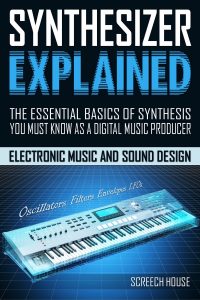What exactly is filter resonance and why do you need to know how to set a resonance frequency peak? Here’s the answer…
The filter resonance function is an essential part of a (subtractive) synthesizer that you can usually find in the filter area.
What are filters?
Now, what exactly are filters? Filters are functions on a synthesizer that can enhance and/or reduce certain frequency ranges in your sound. You see, any sound consists of frequencies that your ears can pick up. So, with a filter you can adjust them, which change the so-called “harmonic” balance of the sound.
As you can imagine, this can come in handy to produce a wide variety of different sounds. Thus, it’s very important to understand all the settings that come with it, such as the filter resonance.
How to use filter resonance
Resonance, res for short, is a special function and how it works depends on the filter type. It either sets the amplitude of a narrow frequency band at the cutoff point. Or, it sets the frequency bandwidth centered at the cutoff point. Okay, that sound too complex. So, let’s simplify.
If you select a low pass or high pass filter type, the resonance will create a sharp volume boost at the cutoff frequency. A narrow bell curve if you will. So, by changing the amount of resonance, you will change the loudness of this volume peak. Thereby, more resonance means a bigger frequency peak and less resonance means a smaller frequency peak.
However, if you select the band pass filter type, the resonance will work differently. It will now give you the option to control how many frequencies should pass. Call it a frequency band if you will. Whereby, more resonance means a narrow band of frequencies and less resonance means a wider band of frequencies. Also, depending on your synth, adding resonance may boost the volume of the band as well.
Play with the filter resonance
So, depending on the filter type, you can use the resonance to create a frequency peak or set the frequency bandwidth. Thereby, it’s your job to find the effect you wish to create. Once you’re happy with it, you can tweak the other settings, which we will explore next in the complete “Synthesizer for beginners” series.
Synthesizer for beginners
The “Synthesizer for Beginners” series is a huge collection of quick lessons about sound design and synthesis. Each lesson explains one part of how a subtractive synthesizer works, which is vital to know if you’re an electronic music producer.
Most people have the attention span of a butterfly and therefore miss all the important tips later in my videos and posts. Still, I don’t want you to miss a thing and that’s why you will see these short clips on Screech House. Each short clip explains a bite-sized topic from one of my longer videos. This gives everyone the chance to focus solely on what they need and thereby also saving a lot of time.
Today’s short clip is from the 4-part “Synthesizer Explained” video course. Watch the full episodes here:
Synthesizer explained!
The “Synthesizer Explained” video course is now finally available as an exclusive guide. This easy-to-read book is jam-packed with valuable info about the essential basics of sounds design, including practical tips and bonus cheat sheets.
Since the day of release, many people have already read it. But if you haven’t, click this link to get your copy: Synthesizer Explained.
Make sure to get it now, else you risk being too late and miss out.

